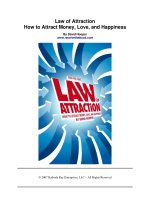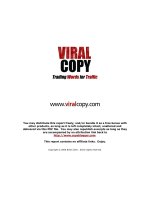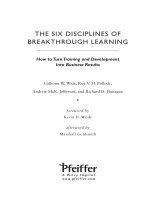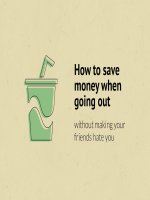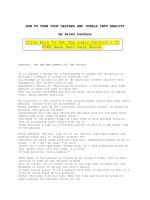Landing pages how to turn traffic into money
Bạn đang xem bản rút gọn của tài liệu. Xem và tải ngay bản đầy đủ của tài liệu tại đây (316.33 KB, 46 trang )
Landing
Pages
H OW TO TU R N TR A FFI C
I NTO M O N E Y
L A N D I N G PA G E S - H O W TO T U R N T R A F F I C I N TO M O N E Y
Feel free to email, tweet, blog, and
pass this ebook around the web
... but please don’t alter any of its contents when you do. Thanks!
Copyright © 2016 Rainmaker Digital, LLC
All Rights Reserved
copyblogger.com
2
L A N D I N G PA G E S - H O W TO T U R N T R A F F I C I N TO M O N E Y
Successful marketers know that it’s ridiculous to create a product or
email newsletter, and then spoil the launch by promoting it through their
home page.
They know that the home page is a hot mess of choices that will distract
potential customers.
Thus, the popularity of the highly-focused landing page.
See, landing pages convert dramatically better than a home page, increasing
your membership site sign-ups, ebook downloads, or product sales …
But what makes landing pages so powerful?
The secret is their ability to segment your audience into subsets of consumers
… aligning the right message with the right audience at the right time …
using landing pages.
You can grow your email subscriber list faster, sell more digital products in less
time, squeeze more students into your membership program …
But what is a landing page? And how do you “segment your audience
into subsets of consumers”? Those questions and more will be answered in
this ebook.
3
L A N D I N G PA G E S - H O W TO T U R N T R A F F I C I N TO M O N E Y
As you read you’ll discover:
•• 3 essential metrics you need to know to improve successful
landing pages
•• How crappy landing pages kill email campaigns
•• 7 steps to an email-opt in landing page that works
•• What makes an effective landing page like a direct mail letter
•• The best piece of advice for improving landing page conversions
•• If you are killing your landing page conversion rates by breaking one of
these 10 laws
Once you’re finished with this ebook you’ll know that the key to creating
landing pages boils down to simplicity … in fact, you’ll learn that creating the
ultimate landing page is not as hard as you think.
So whether you are a seasoned landing page creator with years of experience
under your belt or a greenhorn who furrows your brow at the mention of
landing pages … this guide will teach and remind you of the essential steps to
creating the ultimate landing page, and the critical mistakes to avoid.
4
L A N D I N G PA G E S - H O W TO T U R N T R A F F I C I N TO M O N E Y
5 Landing Page Mistakes that Crush
Conversion Rates
A landing page is a place you send traffic when you really want some action.
And no, this has nothing to do with Craigslist personals.
It can be a sales page, an email opt-in page, a video landing page, or even a
content landing page designed to rank well in search engines. As you might
have guessed, there are a lot of ways to screw these up.
Here are five of the most common mistakes people make with their
landing pages.
1. Blowing the headline
Landing pages live or die by the quality of the headline. It’s your two-second
chance to overcome the swift and brutal attention filters we’ve developed due
to information overload and poorly-matched promises.
Often, a better headline alone will boost the effectiveness of your landing
page, and even overcome some of the other mistakes below. Split-testing
different headlines is relatively painless, and can bring you much higher
conversions compared with multiple other tweaks.
5
L A N D I N G PA G E S - H O W TO T U R N T R A F F I C I N TO M O N E Y
2. Using your regular site design
Most of us who use content marketing as an attraction strategy use a content
management system, such as WordPress. That means we’re using design
themes for the visual presentation of our sites.
While your typical sidebar-and-header approach to a blog post is fine, when it
comes down to traffic hitting a landing page with a singular focus on specific
action, all of that extraneous stuff causes confusion, distraction, and reduced
conversions. Lose the clutter and create the cleanest page possible when you
want some action.
3. Asking for more than one thing
The idea that more choices make people happier has been proven to be a
psychological fallacy time and again. This “paradox of choice” reveals that
when given multiple options, the decision ends up being not to choose at all.
An effective landing page asks for one specific action, and that’s it. And don’t
forget to actually clearly ask for that one specific thing, which is an even
bigger conversion killer if you don’t.
6
L A N D I N G PA G E S - H O W TO T U R N T R A F F I C I N TO M O N E Y
4. Ignoring basic aesthetics
Why is it when some people decide to ask for some action, they lose their
minds on the appearance of the page? Bad fonts, garish colors, cheap
highlighting, and silly clip art do not make for better conversions in most
cases. What they do is crush your credibility.
While using your standard blog theme is distracting and confusing in
the landing page context, there’s no need to become the typographical
equivalent of a carnival barker, either. Great landing pages use fonts, colors,
and visuals that are tailored specifically to the audience and action you desire,
thereby enhancing the experience and boosting conversions.
5. Being lazy
Did you know that web users spend 80% of their time above the fold? Does
that mean people won’t scroll down the page? No, it just means you can’t take
it for granted that they will (instead of leaving).
Don’t be lazy about grabbing and holding attention. Don’t assume everyone
instantly “gets” the benefit of your offer the way you do. Don’t overestimate
your credibility. In short, don’t drink your own Kool-Aid. Think about it from
their perspective, and you’ll realize you might not be all that (until you
unequivocally prove you are with compelling copy).
7
L A N D I N G PA G E S - H O W TO T U R N T R A F F I C I N TO M O N E Y
Seal the Deal, Part One: 10 Tips for Writing
the Ultimate Landing Page
by Roberta Rosenberg
I have a client with a deep-pocket online media budget. Google Adwords PPC,
banner ads on major news sites. We’re talking some sizable money to generate
traffic and turn that traffic into customers.
I bet you’re thinking a big part of their budget was earmarked for landing
page development and testing. I would have thought so, too, before they
became a client. But what I quickly discovered was this – there wasn’t a series
of landing pages. There wasn’t even one landing page! All of the clicks, all of
their costly PPC traffic was being directed to the home page.
Literally, their best prospects were being dumped off at the front door with
little direction or guidance as to how to proceed.
Yikes.
Now just to be fair, literally any page of your site or blog is a landing page
of sorts.
8
L A N D I N G PA G E S - H O W TO T U R N T R A F F I C I N TO M O N E Y
To my mind, every page should be optimized to move your visitor
along whatever path you’ve set forth toward a sale, a newsletter or blog
subscription, what have you.
But for the purposes of this chapter, I’ll confine myself to those landing
pages where your prospect initiated some sort of response to an ad. This
could be a PPC (pay-per-click) ad like Google Adwords, a banner or text ad,
or even an email.
In this scenario, your prospect has initiated some sort of relationship with you.
Your landing page acknowledges this and provides additional information –
benefits/features – and a clear path to the next step.
So let’s look at 10 key steps to writing and designing a landing page that will
help get you the results you’re looking for:
9
L A N D I N G PA G E S - H O W TO T U R N T R A F F I C I N TO M O N E Y
On Writing
1. Make sure your headline refers directly to the
place from which your visitor came or the ad copy
that drove the click.
Match your language as exactly as you can (close is good, exact is best).
This way you keep your visitor oriented and engaged. This is by far the most
important part of your landing page.
2. Provide a clear call to action.
Whether you use graphic buttons or hotlinked text (or both), tell your visitor
what they need to do. I use a minimum of 2 calls to action in a short landing
page, 3-5 in a long landing page. Copy tests here will give you the biggest
bang next to testing headlines.
3. Write in the second person – You and Your.
No one gives a rat’s patootie about you, your company, or even your product
or service except as to how it benefits him or her. (The bigger the company
the more time I spend rewriting their stuff from We to You.)
10
L A N D I N G PA G E S - H O W TO T U R N T R A F F I C I N TO M O N E Y
4. Write to deliver a clear, persuasive message,
not to showcase your creativity or ability to turn a
clever phrase.
This is business, not a personal expression of your art. (Every copy coaching
student hears me say this at least once.)
5. You can write long copy as long as it’s tight.
I always err on writing a little long on the first drafts because it’s easier to edit
down than to pad up skimpy copy. Your reader will read long copy as long as
you keep building a strong, motivating case for him/her to act. However, not
every product or service will require the same amount of copy investment.
Rule of thumb: Think longer copy when you’re looking to close a sale. Think
shorter copy for a subscription sign-up or something that doesn’t necessarily
require a cash commitment.
6. Be crystal clear in your goals.
Keep your body copy on point as a logical progression from your headline and
offer. Don’t add tangential thoughts, ancillary services, and generic hoo-hah.
11
L A N D I N G PA G E S - H O W TO T U R N T R A F F I C I N TO M O N E Y
Hoo-hah makes the client feel good but wastes the reader’s time. Every
digression is a conversion lost.
7. Keep your most important points at the
beginning of paragraphs and bullets.
Most visitors are skimming and skipping through your copy. Make it easy for
them to get the joke without having to slow down.
8. In line with #7, people read beginnings and ends
before they read middles.
Make sure you keep your most critical, persuasive arguments in these
positions.
9. Make your first paragraph short, no more than
1-2 lines (that’s lines, not sentences).
Vary your paragraph line length from here. It helps create visual dissonance
and makes it easier to read your copy. And no paragraph should be more than
4-5 lines long at any time.
12
L A N D I N G PA G E S - H O W TO T U R N T R A F F I C I N TO M O N E Y
10. Write to the screen.
Take a piece of paper and frame out where your text, buttons, and design
elements will go.
Consider how much of your content will be seen “above the fold” or at the
first screen.
You can still go long and have visitors scroll downward. If so, you’ll want
to make sure you repeat essential calls to action, testimonials, and other
components so no matter where your visitor is, an ACT NOW link or button
remains visible.
3 Bonus Tips:
11. Remove all extraneous matter from your
landing page.
This includes navigation bars, visual clutter, and links to other sections. You
want the reader focused solely on your copy, your supportive visuals, and the
offer you’re making without being tempted to wander around the room.
13
L A N D I N G PA G E S - H O W TO T U R N T R A F F I C I N TO M O N E Y
12. Don’t ask for what you don’t need.
Ask for only enough information to complete the sale or the desired action.
This isn’t the time to conduct a marketing survey. Every question you ask,
every piece of information you require will chip away at your response.
Be judicious.
13. Assume nothing. Test everything.
These tips and techniques will get you started, but they just scratch the
proverbial surface. Design elements are critical, too — color, images, layout —
as well as video, audio, and other interactivity elements whose purpose is to
more deeply engage the reader and boost response. They all merit a deeper
look and testing where it makes sense.
14
L A N D I N G PA G E S - H O W TO T U R N T R A F F I C I N TO M O N E Y
Seal the Deal, Part Two: 5 Tips for
Designing the Ultimate Landing Page
In the last chapter I devoted most of my time to copywriting tips since, well,
I’m a copywriter.
I craft the words.
Unlike direct mail, however, the web is a strongly visual medium. Good design
helps support the content, leading the visitor’s eye from here to there and
directing them through your message layer by layer, step by step.
This is especially so in the formatting of an effective landing page. That’s why
I’ll devote myself to the overall look, feel, and formatting of effective landing
pages for this article.
Copywriters don’t have to be designers. But copywriters who understand
effective landing design fundamentals — what works and what doesn’t — will
be better able to work and share ideas with designers. That means you and
your entire creative team will be on board and working toward the common
goal of capturing more conversions.
A while ago Omniture published a white paper called Best Practices for
Conversion: The New Engagement Funnel in 7 Steps.
15
L A N D I N G PA G E S - H O W TO T U R N T R A F F I C I N TO M O N E Y
Their “Step #3: Organize and Optimize Site Structure” does a nice job of laying
out some basic guidelines that will help you organize and format your copy for
maximum results:
•• Scrutinize your competition’s design and organization flow of their
landing pages: Go through their conversation process and note the
places where you feel a bit stumped or put off. Then go back to your
own landing page and compare. Consider what you could revise or
eliminate for better effect.
•• Put your most critical landing page elements in the upper 300
pixels of the page: Usability research shows over half of your site
visitors will NOT scroll “below the fold,” so forget the warm-up copy, get
right to the point, and keep your value proposition at first screen view.
•• Think simple: Use a one-column format with ample margins and white
space to increase reading comprehension. Break up big paragraphs
into smaller paragraphs -- and no more than 5 lines per. You want to
encourage visitors to read and engage with your message. Denselooking copy doesn’t get read, period.
•• Be obvious and use standard usage conventions: Underline your
links, be clear, descriptive, and specific when describing them. No visitor
should have to work to use your page or understand your message.
16
L A N D I N G PA G E S - H O W TO T U R N T R A F F I C I N TO M O N E Y
•• Make sure your page loads quickly: Depending on your marketing
and your product/service mix, strive for a 3-second or less page load.
Don’t plump your page with unnecessary graphics. Optimize essential
graphics to reduce file size and load time.
But wait, there’s more! Here are 5 more tips you’ll
want to review and keep handy:
•• Format your page according to the F-Pattern Eye-Tracking Principle:
Web readers tend to track through content in a rough F-shaped pattern,
so format important images flush left. For more on this, see Jakob
Nielsen’s eye tracking research.
•• Use the same color palette/visual elements from your ads on your
landing page: There should be a smooth, consistent flow to help keep
your prospect oriented and assured that they are indeed “landed” in the
right place.
•• No clipart! Choose a single dominant photo image to be your hero
shot: Use a product photo or, in the case of a service, you could use your
logo or even a photo of your location. Make it clickable and don’t forget
to add a benefit-rich caption.
17
L A N D I N G PA G E S - H O W TO T U R N T R A F F I C I N TO M O N E Y
•• Put your message, copy, or image close to the middle of your
page. Less critical elements can be placed in sidebars or perhaps even
eliminated.
•• Make it easy to complete your input form: For example, have the
input cursor hop instantly from field to field upon completion. Let your
user tab around fields. No drop-down menus … require only a checkbox
action. And my personal favorite — auto-populate any fields you can.
Remember, your landing page is your visitor’s last stop to buy something
outright or Step 2 if lead generation is your goal. Whether it’s one step or one
of many, your copy and design has to focus on firing up your visitor’s selfinterest as well as build confidence and trust in your product/service and in
you/your company.
So be honest, forthright, and leave the “cheese” behind.
18
L A N D I N G PA G E S - H O W TO T U R N T R A F F I C I N TO M O N E Y
“Keep it Simple, Stupid” Applies to Your
Landing Pages, Too!
There’s an old direct marketing axiom stating that too many choices paralyzes
your prospect into complete non-action.
But does that behavior apply to landing pages? Marketing Experiments
Journal did a recent study on the topic, Landing Page Confusion: How Does
Having More Than One Objective to a Page Affect its Performance?
They tested their hypothesis using real-world companies to illustrate 5
fundamental principles of landing page design. They reviewed an online
electronics retailer, large national newspaper, and a paid subscription site.
Some pages started out better than others, but all had room for improvement.
So what did they learn?
In every case, landing page effectiveness and measured conversion
increased significantly when choices and unnecessary distractions
were eliminated — and the overall design and orientation of the page
emphasized the call to action.
Here’s a list of the Journal’s specific recommendations:
19
L A N D I N G PA G E S - H O W TO T U R N T R A F F I C I N TO M O N E Y
•• Focus on one objective for each page. Define your objective and drive
everything on the page to it.
•• Sales pages should use a vertical flow through the center of the
page. For commercial offer pages, vertical single-column body copy
through the center of the page consistently performs better than other
layouts and should always be tested. Left or right columns should be
used to support movement toward the objective such as testimonials
(to reduce anxiety at clicking the Order button).
•• One of the changes they made, for example, was to swap out the
left-column navigation, replace it with testimonials, and move the
navigation to the far-right column. You could try that, or move the
navigation to the bottom of the page, or delete it.
•• Eliminate elements that may distract eye path from flow toward the
objective. If page elements such as photos and graphic images don’t
move your visitor briskly to taking the desired action, dump them. Every
element on the page has to work in concert toward the same goal.
•• Use visual elements (size, motion, color, position, and shape) to
draw attention toward the call to action. Don’t guess. Test it all to find
what works best for you.
20
L A N D I N G PA G E S - H O W TO T U R N T R A F F I C I N TO M O N E Y
•• Avoid using off-page links. Use passive pop-ups or launch new
browser windows when needed to provide details or supplemental
decision information. Once visitors have left the page, their forward
momentum is interrupted and must be re-established even if they do
return. By eliminating the number of clicks it takes to act, you keep a
visitor longer and more engaged with your message.
No surprises here for me. As my Grandma Fanny used to say, “You can’t dance
at two weddings with one tuchas.” (That’s Yiddish for backside.) Define your
objective (singular, not plural) and stick with it. Make sure every word, graphic,
icon keeps your prospect focused on the one single action that will satisfy the
your single, most-important objective.
Not as easy as I make it sound, I know. Clients tend to want to “kitchen sink”
every pixel of web page real estate.
So make sure you keep your evidence and test results like these close at
hand. And if your client or boss balks, tell them to talk to me. I’ll be happy
to set ‘em straight.
21
L A N D I N G PA G E S - H O W TO T U R N T R A F F I C I N TO M O N E Y
How is an Effective Landing Page Like a
Direct Mail Letter?
Answer: They’re both formatted for one column.
In his audio article, “6 Ways to Increase Conversions on your Web Pages,” Nick
Usborne, one of my favorite copywriter colleagues, talks about the multitude
of testing he’s done on landing pages and column formatting.
Long and short, the one-column format converts best every time.
This explains the stubborn effectiveness of everyone’s favorite (or not) online
long-form sales letters.
Garish? Sometimes.
Too long? Perhaps.
But they work, in part, because there are no other distractions for the reader.
Even with all the insets, widgets and gadgets, each is firmly ensconced within
the one column. Further, the one-column format lets readers know that there’s
more to look for below the fold of the first screen. The convention of the letterlike, one-column design tells them so.
22
L A N D I N G PA G E S - H O W TO T U R N T R A F F I C I N TO M O N E Y
Like the traditional sales letter, the one-column landing page offers a stepby-step selling sequence for your reader. The headline moves the reader to
the subhead, etc. Add columns filled with links, even something as simple as
navigational links, and you’ve given the reader a reason to look and click away
from your message.
Nick says, and I concur, one-column may be the best way to go. Test it yourself
and see if it makes a difference.
23
L A N D I N G PA G E S - H O W TO T U R N T R A F F I C I N TO M O N E Y
7 Steps to an Email Opt-in Page That
Works
by Brian Clark
Email marketing works.
In fact, it’s still the best online method for converting prospects into customers
or clients.
A critical part of the process begins, however, before a single email is sent.
You’ve got to get people on your list in the first place.
This happens most effectively at a landing page specifically designed to
convince the right people to sign up.
Some people call these opt-in landing pages “squeeze” pages, which,
in addition to being a derogatory way to think about the process, is also
technically incorrect.
Here’s a quick Internet marketing history lesson: a squeeze page was
originally a very specific type of opt-in page which required you to supply an
24
L A N D I N G PA G E S - H O W TO T U R N T R A F F I C I N TO M O N E Y
email address just for the privilege of reading a sales letter. If you didn’t buy
immediately, you got follow-up pitches.
Sounds crazy now, huh?
But things were easier back then, until hucksters and charlatans abused the
privilege and people fought back.
I’m about to show you how to win the trust and interest of prospective
subscribers despite any initial misgivings your audience may have.
Let’s jump right in.
1. Who do you want?
The first step is crucial, and yet time and again I see people plow ahead
without a clear understanding of exactly the type of person they want on their
email list.
Without a clear and detailed understanding of who you want, you can’t craft a
message that resonates strongly enough to spark interest and gain trust.
25



